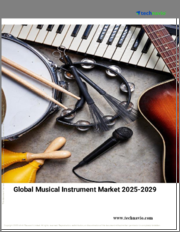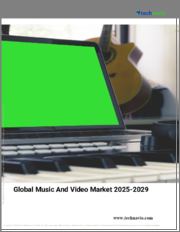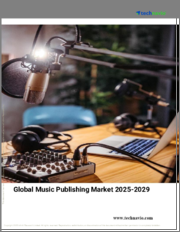
|
시장보고서
상품코드
1616859
세계의 음악 출판 시장 규모 : 권리 유형별, 수익원별, 최종사용자별, 지역별, 범위 및 예측Global Music Publishing Market Size By Type of Rights, By Revenue Source, By End-Users, By Geographic Scope And Forecast |
||||||
음악 출판시장 규모와 전망
음악 출판 시장의 시장 규모는 2023년 60억 달러로 평가되며, 2024년부터 2030년까지 연평균 8.95% 성장하여 2030년에는 96억 6,000만 달러에 달할 것으로 예측됩니다.
음악 출판 시장 세계 시장 촉진요인
음악 출판 시장의 시장 촉진요인은 다양한 요인의 영향을 받을 수 있습니다.
디지털 스트리밍의 성장:
디지털 스트리밍의 성장: 음악 소비가 증가함에 따라 저작권과 로열티를 다루는 음악 출판 서비스의 필요성이 증가하고 있습니다. 이는 디지털 스트리밍 플랫폼의 부상에서 확인할 수 있습니다.
세계의 음악 소비량:
스마트폰과 인터넷의 보급으로 음악 소비는 전 세계적으로 확산되고 있습니다. 이에 따라 음악 출판사에 대한 다양한 시장에서의 권리 관리 수요가 증가하고 있습니다.
새로운 수익원의 출현:
수익을 창출하기 위해 음악 출판사는 비디오 게임, TV 프로그램, 영화 동기화 라이선싱과 같은 새로운 수익원을 활용하고 있습니다.
독특한 컨텐츠에 대한 수요:
독특한 컨텐츠에 대한 인디 아티스트, 소셜 미디어 사용자 및 스트리밍 플랫폼의 수요가 증가함에 따라 음악 출판사는 음악 컬렉션에서 라이센스를 획득하고 수익을 창출할 수 있는 기회가 많아졌습니다.
레코드사 간 협업:
뮤지션과 음악 출판사의 협업이 증가하고 있습니다. 이는 새로운 합작 투자, 협업, 라이선싱의 기회를 창출하고 음악 출판 부문에 수익을 가져다 줄 수 있는 기회를 제공합니다.
기술 개발:
음악 출판 과정의 효율성과 투명성은 투명한 로열티 모니터링을 위한 블록체인, AI 기반 컨텐츠 추천 알고리즘 등의 기술 개발을 통해 강화되고 있습니다.
메타데이터의 중요성 증대:
디지털 시대에 권리 관리, 컨텐츠 검색, 로열티 모니터링의 필요성으로 인해 음악 출판에서 정확한 메타데이터의 중요성이 커지고 있습니다.
라이브 이벤트의 성장:
콘서트, 페스티벌, 투어 등 라이브 이벤트가 증가함에 따라 음악 출판사는 공연권을 라이선싱하고 라이브 공연으로 수익을 창출할 수 있는 기회가 많아졌습니다.
음악 시장의 세계화:
음악 출판사는 음악 시장의 세계화와 국경을 초월한 협업을 통해 라이선싱 및 유통 네트워크를 국제적으로 확장할 수 있는 기회를 얻고 있습니다.
개인화 된 음악 경험의 필요성:
AI 기반 추천 엔진과 정교하게 만들어진 플레이리스트는 개인화된 음악 경험에 대한 니즈를 높이고 있습니다.
세계 음악 출판 시장의 억제요인
음악 출판 시장에는 몇 가지 요인이 억제요인으로 작용할 수 있습니다. 다음은 그 중 한 가지 예이다:
불법복제 및 저작권 침해:
이 두 가지 문제는 음악 출판 부문에 계속 심각한 문제를 일으켜 경제적 손실과 법적 분쟁을 일으키고 있습니다.
복잡한 저작권 관리:
라이선싱, 로열티 분배 및 저작권 행사는 여러 이해관계자가 존재하고 권리 소유자가 분산되어 있는 복잡한 권리 관리로 인해 더욱 어려워지고 있습니다.
실물 매출 감소:
음악 출판사는 CD, 음반 등 실물 음악 판매가 감소하고 수익원이 감소함에 따라 디지털 유통 전략에 적응해야 합니다.
스트리밍 플랫폼으로부터의 압력:
특히 독립 출판사와 작곡가의 경우, 수익 배분 계약과 스트리밍 사용료가 음악 출판사의 수익에 영향을 미칠 수 있습니다.
세분화된 비즈니스 환경:
로열티 분배와 징수는 음악 출판 사업의 단편적인 특성으로 인해 복잡하고 비효율적일 수 있습니다. 이 비즈니스는 징수 협회, PRO(공연권 단체) 및 수많은 출판사에 의해 지배되고 있습니다.
라이선싱의 어려움:
음악 출판사는 복잡한 라이선스 계약과 시청각 컨텐츠의 동기화 라이선스 확보와 같은 라이선스 문제로 인해 수익 창출에 어려움을 겪을 수 있습니다.
데이터의 투명성 및 품질:
저조한 데이터 품질과 로열티 보고 및 분배의 불투명성으로 인해 음악 출판사와 권리자 간의 불일치 및 의견 차이가 발생할 수 있습니다.
DIY 플랫폼의 경쟁자:
기존의 음악 출판사는 뮤지션들이 기존의 음악 출판 서비스를 우회할 수 있는 DIY(Do It Yourself) 플랫폼과 직접 유통 채널의 등장으로 경쟁에 직면해 있습니다.
규제의 변화:
음악 출판사의 법적 환경과 상업적 전략은 저작권 개혁 및 디지털 저작권 관리법 등 규제 변화에 영향을 받을 수 있으며, 이에 대한 적응 및 준수 활동이 필요합니다.
시장의 불확실성:
음악 출판 부문의 안정성과 성장 전망은 소비자 선호도 변화, 기술적 혼란, 경기 침체 등 시장의 불확실성에 영향을 받을 수 있습니다.
목차
제1장 소개
- 시장 정의
- 시장 세분화
- 조사 방법
제2장 주요 요약
- 주요 조사 결과
- 시장 개요
- 시장 하이라이트
제3장 시장 개요
- 시장 규모와 성장의 가능성
- 시장 동향
- 시장 성장 촉진요인
- 시장 성장 억제요인
- 시장 기회
- Porter's Five Forces 분석
제4장 음악 출판 시장 : 권리 유형별
- 기계적 권리
- 공연권
- 싱크권
제5장 음악 출판 시장 : 수익원별
- 로열티
- 싱크 라이선싱
- 구독
제6장 음악 출판 시장 : 최종사용자별
- 레코드 회사
- 아티스트 및 작곡가
- 미디어 및 엔터테인먼트 기업
제7장 지역 분석
- 북미
- 미국
- 캐나다
- 멕시코
- 유럽
- 영국
- 독일
- 프랑스
- 이탈리아
- 아시아태평양
- 중국
- 일본
- 인도
- 호주
- 라틴아메리카
- 브라질
- 아르헨티나
- 칠레
- 중동 및 아프리카
- 남아프리카공화국
- 사우디아라비아
- 아랍에미리트
제8장 시장 역학
- 시장 성장 촉진요인
- 시장 성장 억제요인
- 시장 기회
- COVID-19의 시장에 대한 영향
제9장 경쟁 구도
- 주요 기업
- 시장 점유율 분석
제10장 기업 개요
- Universal Music Group(UMG)(France)
- Sony Music Entertainment(Japan)
- Warner Music Group(WMG)(USA)
- Concord Music Group(USA)
- BMG Rights Management(Germany)
- Kobalt Music Group(UK)
- SESAC(USA)
- ASCAP(USA)
- BMI(USA)
제11장 시장 전망과 기회
- 신기술
- 향후 시장 동향
- 투자 기회
제12장 부록
- 약어 리스트
- 정보 출처와 참고문헌
Music Publishing Market Size And Forecast
Music Publishing Market size was valued at USD 6.0 Billion in 2023 and is projected to reach USD 9.66 Billion by 2030 , growing at a CAGR of 8.95% during the forecast period 2024-2030. Global Music Publishing Market Drivers The market drivers for the Music Publishing Market can be influenced by various factors. These may include: Growth of Digital Streaming:
As a result of rising music consumption, there is a greater need for music publishing services to handle copyrights and royalties. This is seen in the rise of digital streaming platforms.
Global Music Consumption:
Due to the widespread use of smartphones and the internet, music consumption has become more widespread worldwide. This has increased the demand on music publishers to manage rights in a variety of markets.
Emergence of New Revenue Streams:
To boost revenue, music publishing organizations are taking use of new revenue streams like video game, TV show, and movie synchronization licensing.
Demand for unique Content:
Music publishers now have more chances to license and profit from music collections thanks to the growing demand for unique content from independent artists, social media users, and streaming platforms.
Collaboration Amongst Record Labels:
Musicians, and music publishers is increasing. This leads to new joint ventures, collaborations, and licensing opportunities that provide income for the music publishing sector.
Technological Developments:
The efficiency and transparency of music publishing processes are being enhanced by technological developments such as blockchain for transparent royalties monitoring and AI-driven content recommendation algorithms.
Growing Significance of Metadata:
In the digital age, the requirement for rights management, content discovery, and royalty monitoring has led to a growing significance of precise metadata in music publication.
Growth of Live Events:
Music publishers now have more chances to license performance rights and make money from live performances as a result of the growth of live events including concerts, festivals, and tours.
Globalization of Music Markets:
Music publishers have the opportunity to grow their licensing and distribution networks internationally through the globalization of music markets and cross-border collaborations.
Need for Personalized Music Experiences:
AI-powered recommendation engines and carefully crafted playlists are fueling the need for personalized music experiences, which gives record labels the chance to license and profit from a wide range of musical works.
Global Music Publishing Market Restraints
Several factors can act as restraints or challenges for the Music Publishing Market. These may include:
Piracy and Copyright Violations:
These two issues continue to pose serious problems for the music publishing sector, resulting in financial losses and legal conflicts.
Complicated Copyright Management:
Licensing, royalty distribution, and copyright enforcement are made more difficult by the complexity of rights management, which includes several stakeholders and dispersed rights ownership.
Decline in Physical Sales:
Music publishers must adjust to digital distribution strategies as a result of the drop in physical sales of music, including CDs and vinyl albums, which lowers their revenue streams.
Pressure from streaming Platforms:
on revenue sharing agreements and streaming royalty rates may have an effect on music publishers' earnings, particularly for independent publishers and composers.
Fragmented business Landscape:
The distribution and collection of royalties can be complicated and inefficient due to the fragmented nature of the music publishing business, which is dominated by collecting societies, PROs (Performance Rights Organizations), and a multitude of publishers.
Difficulties in Obtaining Licensing:
Music publishers may face difficulties in generating revenue due to licensing issues, such as intricate licensing agreements and securing synchronization licenses for audiovisual content.
Data Transparency and Quality:
Inconsistencies and disagreements between music publishing companies and rights holders can result from poor data quality and opaqueness in royalty reporting and distribution.
DIY Platforms' Competition:
Established music publishers face competition from the emergence of DIY (do-it-yourself) platforms and direct distribution channels, which enable musicians to circumvent traditional music publishing services.
Regulatory Shifts:
The legal environment and commercial strategies of music publishers may be impacted by regulatory shifts, such as copyright reform and laws pertaining to digital rights management, necessitating adaptation and compliance activities.
Market Uncertainty:
The stability and growth prospects of the music publishing sector can be impacted by market uncertainties such as shifts in consumer tastes, technological disruptions, and economic downturns.
Global Music Publishing Market Segmentation Analysis
The Global Music Publishing Market is Segmented on the basis of Type of Rights, Revenue Source, End-Users, and Geography.
By Type of Rights
Mechanical Rights:
Rights related to the reproduction and distribution of musical compositions, including digital downloads, physical sales (CDs, vinyl), and streaming.
Performance Rights:
Rights related to the public performance of musical compositions, including radio broadcasts, live performances, and digital streaming.
Synchronization Rights:
Rights related to the use of music in audiovisual content, including films, TV shows, commercials, video games, and online videos.
By Revenue Source
Royalties:
Revenue generated from licensing fees, royalties, and performance income paid to rights holders, including songwriters, composers, and publishers.
Sync Licensing:
Revenue generated from licensing music for synchronization in audiovisual content, such as films, TV shows, commercials, and video games.
Subscriptions:
Revenue generated from subscription-based music services, including streaming platforms, where users pay a monthly fee for access to music catalogs.
By End-Users
Record Labels:
Music publishing services provided to record labels for managing copyrights, licensing, and royalty collection on behalf of artists and songwriters.
Artists and Songwriters:
Direct music publishing services provided to individual artists, bands, and songwriters for managing their music catalogs, copyrights, and royalties.
Media and Entertainment Companies:
Music publishing services provided to media and entertainment companies, including film studios, TV networks, advertising agencies, and video game developers, for licensing music for audiovisual content.
By Geography
North America:
Including the United States and Canada, characterized by a mature music publishing market with established publishers, PROs (Performance Rights Organizations), and collecting societies.
Europe:
Covering countries such as the United Kingdom, Germany, France, and Italy, with diverse music markets and regulatory frameworks governing music publishing rights and royalties.
Asia-Pacific:
Encompassing regions like China, Japan, South Korea, and India, experiencing rapid growth in digital music consumption and streaming platforms, driving demand for music publishing services.
Latin America:
Including countries such as Brazil, Mexico, Argentina, and Colombia, with growing music markets and increasing demand for music publishing services in film, TV, advertising, and digital media.
Middle East and Africa:
Witnessing emerging music markets and increasing digital penetration, creating opportunities for music publishing services in licensing and rights management.
Keyplayers
The major players in the Music Publishing Market are:
Universal Music Group (UMG) (France)
Sony Music Entertainment (Japan)
Warner Music Group (WMG) (USA)
Concord Music Group (USA)
BMG Rights Management (Germany)
Kobalt Music Group (UK)
SESAC (USA)
ASCAP (USA)
BMI (USA)
TABLE OF CONTENTS
1. Introduction
- Market Definition
- Market Segmentation
- Research Methodology
2. Executive Summary
- Key Findings
- Market Overview
- Market Highlights
3. Market Overview
- Market Size and Growth Potential
- Market Trends
- Market Drivers
- Market Restraints
- Market Opportunities
- Porter's Five Forces Analysis
4. Music Publishing Market, By Type of Rights
- Mechanical Rights
- Performance Rights
- Synchronization Rights
5. Music Publishing Market, By Revenue Source
- Royalties
- Sync Licensing
- Subscriptions
6. Music Publishing Market, By End-Users
- Record Labels
- Artists and Songwriters
- Media and Entertainment Companies
7. Regional Analysis
- North America
- United States
- Canada
- Mexico
- Europe
- United Kingdom
- Germany
- France
- Italy
- Asia-Pacific
- China
- Japan
- India
- Australia
- Latin America
- Brazil
- Argentina
- Chile
- Middle East and Africa
- South Africa
- Saudi Arabia
- UAE
8. Market Dynamics
- Market Drivers
- Market Restraints
- Market Opportunities
- Impact of COVID-19 on the Market
9. Competitive Landscape
- Key Players
- Market Share Analysis
10. Company Profiles
- Universal Music Group (UMG) (France)
- Sony Music Entertainment (Japan)
- Warner Music Group (WMG) (USA)
- Concord Music Group (USA)
- BMG Rights Management (Germany)
- Kobalt Music Group (UK)
- SESAC (USA)
- ASCAP (USA)
- BMI (USA)
11. Market Outlook and Opportunities
- Emerging Technologies
- Future Market Trends
- Investment Opportunities
12. Appendix
- List of Abbreviations
- Sources and References



















